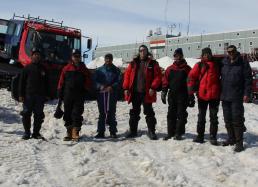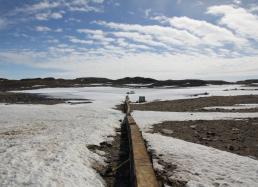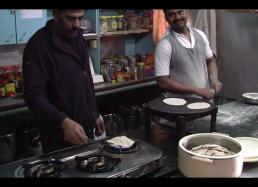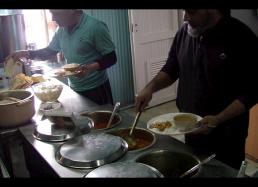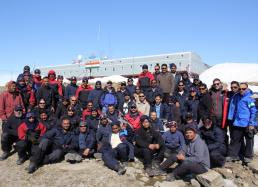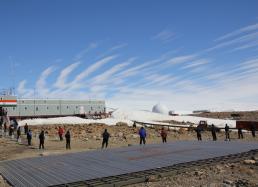5. Life at Maitri Station
After our first fieldwork trip to Lake Untersee, we returned to Maitri Station where we were able to spend some time warming up and preparing for our next field trip. With this in mind, I thought it might be interesting to tell you a bit about how an Antarctic field station works.
A typical field team consists of technical and support staff to keep the station running and includes a commander, a medical doctor, and scientists like geologists, geophysicists, and meteorologists.
There are currently two leaders and teams at Maitri. One team has already spent a summer and winter here and has been at the station for over one year. The other team arrived with me (see Photo #1 below), with some members staying over the summer, and others wintering and returning to India at the end of next summer.
It’s impressive to see that after having spent so much time in Antarctica (far from their families and isolated from the rest of the world), the team members still have such positive, friendly, and motivated spirits!
This must in part be due to the station’s organization and high quality of life: everything is well-cared for, resources are used responsibly (see Photo #2 below), clean washrooms and restrooms are provided, the many daily duties that are required to keep the station running are assigned on a rotating basis, and during off hours, entertainment options abound, such as movies, music, reading, table tennis, and weight-lifting.
Staff members can also attend presentations about a diversity of topics, such as stress management and over-winter syndrome, meditation, and a variety of natural sciences. And perhaps most importantly, satellite internet access provides station members with the opportunity for direct contact and communication with the rest of the world.
Last but not least, the station cook prepares excellent food three times a day—possibly one of the most important factors in keeping station members happy. I never imagined that in Antarctica, of all places, I’d eat some of the best Indian food I’ve ever had! (See Photos #3 and #4 below.)
Special occasions also enliven station life. On several evenings, station members celebrated birthdays—and even a wedding anniversary (obviously with only one of the spouses present). For many, it was their first Antarctic birthday, a special occasion acknowledged by the kitchen team who prepared wonderful birthday cakes.
At each birthday party, the station leaders held speeches and the rest of us were asked to speak or sing a song (see top photo.) Being a terrible singer, I preferred to give a short speech congratulating the lucky ones and thanking the team for their warm hospitality. The parties then continued with some truly remarkable performances of Hindi songs, comedy sessions, and dance.
But back to the day-to-day experience of living at a station…besides accommodating the teams of the two overlapping expeditions, Maitri also hosts transit passengers who have arrived on the continent and are awaiting a connecting flight to another station.
This “layover” can take a day to a week, depending on the weather and availability of ALCI’s Basler Aircrafts, which are responsible for the connecting flights. On one day, the station hosted 75 people, which is about 50% more than the normal occupancy during summer (see Photo #5 below.) The master chef and his team where almost continuously in the kitchen preparing delicious food for the hungry explorers.
Today, four expeditions members, two medical doctors, a meteorologist, and a communications specialist completed their stay of more than a year at Maitri. The station leaders organized a farewell ceremony and everyone lined up outside to say goodbye to their four departing colleagues (see Photo #6 below.) An Indian farewell song, played over the loudspeakers, serenaded the team members as they headed home to their families in India.
In the evenings, my geologist colleagues from the Geological Survey of India (GSI), Mr. Ashit Swain (pronounced: Ah-seet Svey) and Mr. Raghuram, and I discussed and prepared for our fieldwork. We reexamined the models of meteorite concentration, reviewed the scientific collection methods and rules, revisited the methodology and requirements, and inspected all field supplies.
We also reviewed the work of others, such as the long experiences gained by the ANSMET program. We studied the many interesting anecdotes and background information provided by the Antarctic meteorite pioneer Bill Cassidy in his book Meteorites, Ice, and Antarctica. And we reread accounts from scientists we’ve spoken with who have participated in collection expeditions organized by other countries.
Lastly, in preparation for upcoming fieldwork, we identified travel routes to potential meteorite stranding surfaces…. so stay tuned for the results of our next trip!
More soon,
Philipp R. Heck, Ph.D.
The Robert A. Pritzker Assistant Curator of Meteoritics and Polar Studies
A Tawani International Expedition


